The Global Race for Energy Resources
Commodities / Oil Companies Aug 07, 2012 - 02:04 AM GMTBy: Frank_Holmes
 The world watched in awe as American swimmer Michael Phelps became the most decorated Olympian of all time. I’ve read he’s been training in the pool for an average of 6 hours a day, 6 days per week, which equates to about 30,000 hours since age 13 and about 10,000 calories burned during a training day. It’s inspiring to see the incredible results of his tremendous sacrifice and commitment.
The world watched in awe as American swimmer Michael Phelps became the most decorated Olympian of all time. I’ve read he’s been training in the pool for an average of 6 hours a day, 6 days per week, which equates to about 30,000 hours since age 13 and about 10,000 calories burned during a training day. It’s inspiring to see the incredible results of his tremendous sacrifice and commitment.
Investing in global markets requires the same sort of stamina, especially at times like this week, when the month’s reading on the manufacturing industry was not encouraging. The J.P. Morgan Global Manufacturing PMI of 48.4 for July was the lowest since June 2009.
However, I believe there are encouraging pockets of strength to energize and inspire investors.
For example, we’re coming up on the anniversary of the first stimulus move that kicked off the global easing cycle. On August 31, 2011, Brazil unexpectedly cut rates by 50 basis points, and since then, ISI says 228 stimulative monetary and fiscal policy moves have been initiated across several countries, including the Philippines, China, France, and Colombia.
In June and July alone, there were nearly 70 moves—the most since the world began this massive easing.
Generally, by the time central banks make a fiscal or monetary easing move, economic deterioration has already occurred. Even with these moves, it still takes several months for the stimulative measures to take effect and work their way through.
But while the world wades in the shallow end of the pool waiting for the economy to warm up, Asia has taken a deep dive into the energy space as they’ve recently announced acquisitions of Canadian resources companies.
In my presentations, I’ve discussed how resources companies have significantly underperformed their underlying commodities. During 2009 and most of 2010, the performance between oil and the S&P 500 Oil & Gas Exploration and Production Index was closely correlated. By the middle of 2011, oil and oil stocks started to separate, with crude continuing to rise while stocks deteriorated. Even with the recent drop in oil prices, oil stocks have continued to lag.
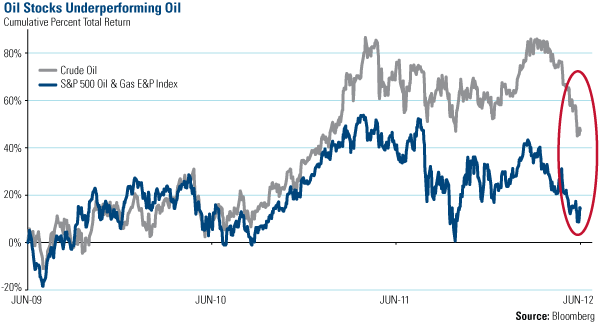
I’ve also discussed the strikingly similar trend occurring between gold and gold stocks. There’s been a spectacular pop in gold stocks recently, but it hasn’t been enough to catch up to gold’s performance.
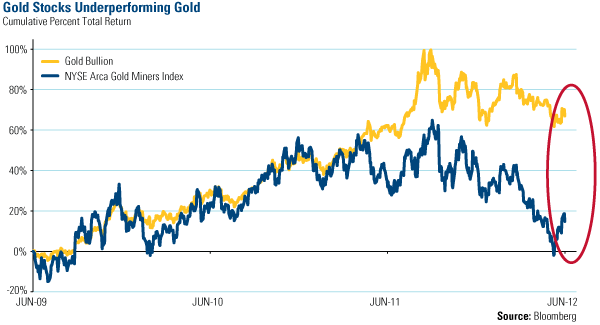
The disparities mean that the cheapest resources are not found in the ground—they’re listed, and it’s been confirmed by recent energy company acquisitions.
Chinese oil company CNOOC put in a bid of $15 billion to purchase Canada’s Nexen. This was at a 61 percent premium to Nexen’s share price on July 20, according to Bloomberg. As you can see below, not only did the takeout announcement close the gap, now the company is outperforming the price of oil.
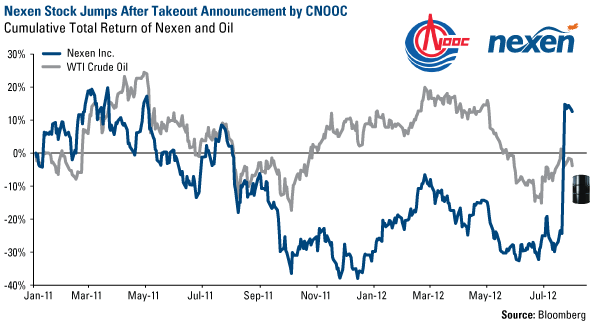
If CNOOC’s deal is approved, the state-run oil giant gets even bigger, gaining access to significant energy stores in several areas of the world, including Canada, the Gulf of Mexico, Colombia and West Africa, as shown below.
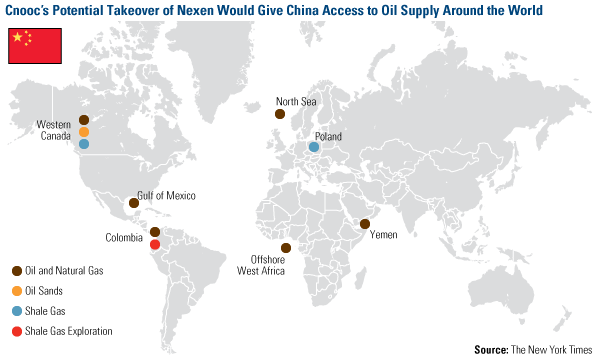
With a rapidly growing middle class and rising urbanization, Chinese leaders know they need to fill their country’s tremendous energy demands and are continually finding innovative ways to keep their country powered. CNOOC’s acquisition is one way China continues to acquire not only the resources needed to power the country, but also the technological innovations that come from countries with free markets and lower barriers to entry. According to The New York Times, China “has been garnering advanced production technologies to better draw oil and gas from nontraditional areas like deepwater fields and hardened rock formations.”
The other announcement came from Malaysia’s state-owned and natural-gas giant Petronas, which will purchase Canada’s Progress Energy Resources Corp. Petronas is one of the largest producers and shippers of supercooled LNG fuel in the world. According to the Vancouver Sun, the company is “anxious to increase its market share in Asia, where analysts expect demand to surge 75 percent by the end of the decade.”
After Petronas’ original bid was announced, Progress increased 74 percent—a record gain for the company, says Bloomberg. As shown below, Progress now dramatically outperforms the underlying commodity.
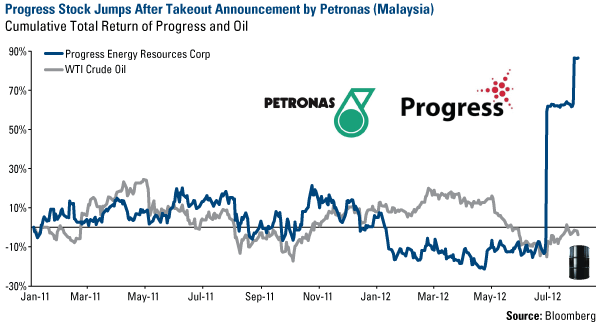
Ready to be a Buyer like Asia?
If you’re contrarian investor, there may be an additional reason to jump into the market today. According to research from J.P. Morgan, institutional investors have become extremely negative, as hedge funds “essentially short the market,” meaning that their expectation is that stocks will fall.
J.P. Morgan looked at the rolling 21-day beta of macro fund returns compared to the S&P 500 Index returns and found that the ratio is at an extreme level of -0.26. Research shows that the last two times the ratio fell this low—in September 2010 and February 2012—stocks rallied. In 2010, the S&P 500 climbed 26 percent in five months; in 2012, stocks rose 8 percent in two months.
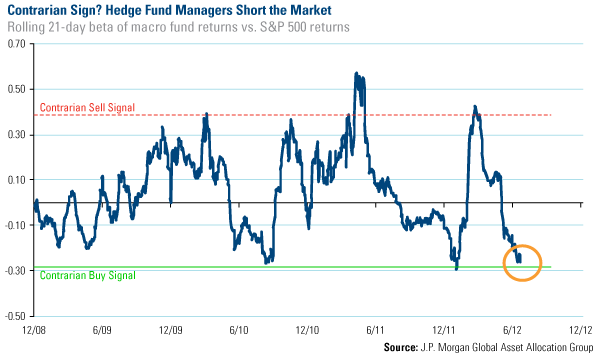
These signs the market is sending out make it an especially attractive time to “mine” for investment opportunity. In July, we began to see energy stocks and oil get recharged, as the energy sector in the S&P 500 was the second best performer, increasing 4.17 percent and crude oil rose 3.68 percent. Unlike the start of an Olympic race, in investing, there isn’t a signal sounded to let you know when to dive off the starting block into the markets. Just make sure your portfolio is poised to participate in the race for resources.
For more updates on global investing from Frank and the rest of the U.S. Global Investors team, follow us on Twitter at www.twitter.com/USFunds or like us on Facebook at www.facebook.com/USFunds. You can also watch exclusive videos on what our research overseas has turned up on our YouTube channel at www.youtube.com/USFunds.
By Frank Holmes
CEO and Chief Investment Officer
U.S. Global Investors
U.S. Global Investors, Inc. is an investment management firm specializing in gold, natural resources, emerging markets and global infrastructure opportunities around the world. The company, headquartered in San Antonio, Texas, manages 13 no-load mutual funds in the U.S. Global Investors fund family, as well as funds for international clients.
All opinions expressed and data provided are subject to change without notice. Some of these opinions may not be appropriate to every investor.
Standard deviation is a measure of the dispersion of a set of data from its mean. The more spread apart the data, the higher the deviation. Standard deviation is also known as historical volatility. All opinions expressed and data provided are subject to change without notice. Some of these opinions may not be appropriate to every investor. The S&P 500 Stock Index is a widely recognized capitalization-weighted index of 500 common stock prices in U.S. companies. The NYSE Arca Gold BUGS (Basket of Unhedged Gold Stocks) Index (HUI) is a modified equal dollar weighted index of companies involved in gold mining. The HUI Index was designed to provide significant exposure to near term movements in gold prices by including companies that do not hedge their gold production beyond 1.5 years. The MSCI Emerging Markets Index is a free float-adjusted market capitalization index that is designed to measure equity market performance in the global emerging markets. The U.S. Trade Weighted Dollar Index provides a general indication of the international value of the U.S. dollar.
Frank Holmes Archive |
© 2005-2022 http://www.MarketOracle.co.uk - The Market Oracle is a FREE Daily Financial Markets Analysis & Forecasting online publication.



